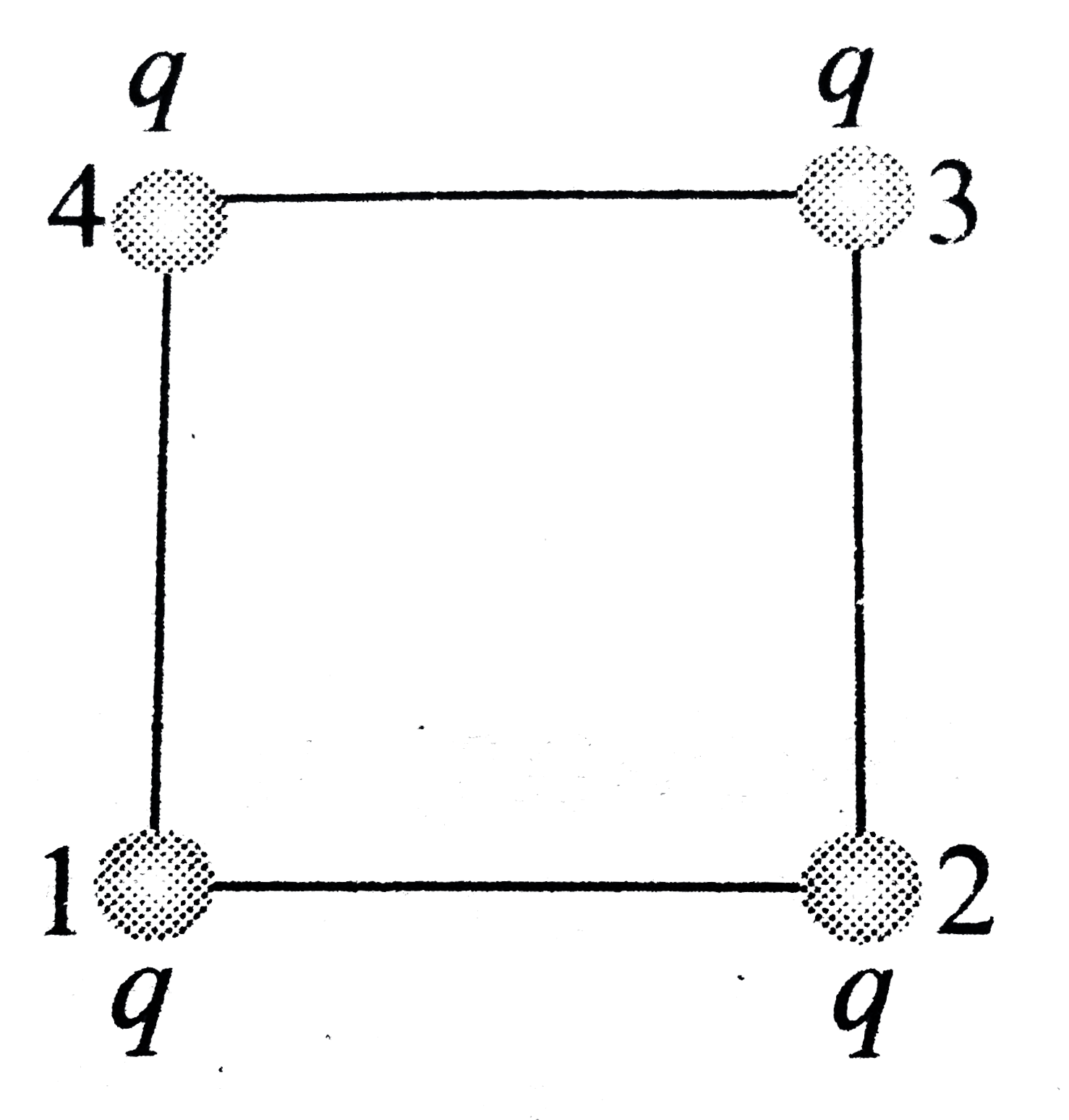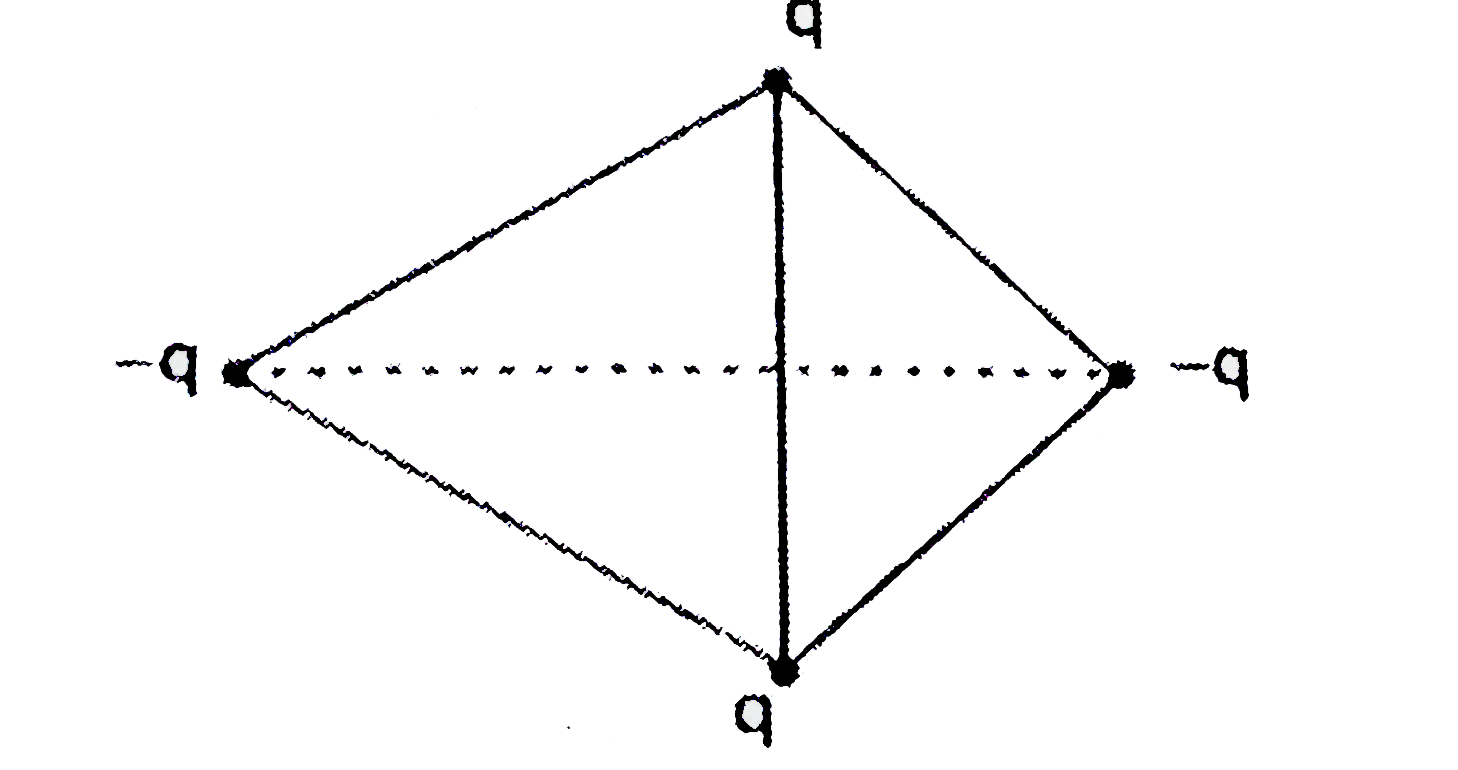Four equal positive charges, each of value Q, are arranged at the four corners of a square of diagonal 2a. A small body of mass m carrying a unit positive charge is placed at height h above the center of the square.
What should be the value of Q in order taht this vody may be in equilibrium?
The correct Answer is:B
To solve the problem step by step, we need to analyze the forces acting on the small body with a unit positive charge placed at a height h above the center of the square formed by the four equal positive charges Q.
Step 1: Understanding the Geometry
- The square has a diagonal of length 2a.
- The side length s of the square can be found using the relationship between the diagonal and the side of the square:
s=2a√2=a√2
- The distance from the center of the square to any corner (where the charges are located) is:
r=s2√2=a
Step 2: Calculate the Distance from the Charge to the Unit Charge
- The distance d from each charge Q at the corners to the unit charge at height h is given by:
d=√a2+h2
Step 3: Calculate the Electric Force from One Charge
- The electric force F exerted by one charge Q on the unit charge is given by Coulomb's law:
F=14πϵ0Qd2=14πϵ0Qa2+h2
Step 4: Resolve the Force into Components
- The force has both vertical and horizontal components. The vertical component Fv (which contributes to balancing the weight of the unit charge) can be found using trigonometry:
- The angle θ between the line connecting the charge and the unit charge and the vertical line is given by:
cosθ=h√a2+h2
- Therefore, the vertical component of the force from one charge is:
Fv=Fcosθ=14πϵ0Qa2+h2⋅h√a2+h2=Qh4πϵ0(a2+h2)3/2
Step 5: Total Vertical Force from All Four Charges
- Since there are four charges, the total vertical force Ftotal acting on the unit charge is:
Ftotal=4⋅Fv=4⋅Qh4πϵ0(a2+h2)3/2=Qhπϵ0(a2+h2)3/2
Step 6: Set Up the Equilibrium Condition
- For the unit charge to be in equilibrium, the total upward force must balance the weight of the unit charge mg:
Ftotal=mg
- Therefore, we have:
Qhπϵ0(a2+h2)3/2=mg
Step 7: Solve for Q
- Rearranging the equation gives:
Q=mgπϵ0(a2+h2)3/2h
Final Answer
Thus, the value of Q required for the small body to be in equilibrium is:
Q=mgπϵ0(a2+h2)3/2h
- The square has a diagonal of length 2a.
- The side length s of the square can be found using the relationship between the diagonal and the side of the square:
s=2a√2=a√2
- The distance from the center of the square to any corner (where the charges are located) is:
r=s2√2=a
- The distance d from each charge Q at the corners to the unit charge at height h is given by:
d=√a2+h2
- The electric force F exerted by one charge Q on the unit charge is given by Coulomb's law:
F=14πϵ0Qd2=14πϵ0Qa2+h2
- The force has both vertical and horizontal components. The vertical component Fv (which contributes to balancing the weight of the unit charge) can be found using trigonometry:
- The angle θ between the line connecting the charge and the unit charge and the vertical line is given by:
cosθ=h√a2+h2
- Therefore, the vertical component of the force from one charge is:
Fv=Fcosθ=14πϵ0Qa2+h2⋅h√a2+h2=Qh4πϵ0(a2+h2)3/2
- Since there are four charges, the total vertical force Ftotal acting on the unit charge is:
Ftotal=4⋅Fv=4⋅Qh4πϵ0(a2+h2)3/2=Qhπϵ0(a2+h2)3/2
- For the unit charge to be in equilibrium, the total upward force must balance the weight of the unit charge mg:
Ftotal=mg
- Therefore, we have:
Qhπϵ0(a2+h2)3/2=mg
- Rearranging the equation gives:
Q=mgπϵ0(a2+h2)3/2h
Thus, the value of Q required for the small body to be in equilibrium is:
Q=mgπϵ0(a2+h2)3/2h
Topper's Solved these Questions
- COULOMB LAW AND ELECTRIC FIELDBOOK - CENGAGE PHYSICS ENGLISHCHAPTER - COULOMB LAW AND ELECTRIC FIELDEXERCISE - Integer
8 Videos
- COULOMB LAW AND ELECTRIC FIELDBOOK - CENGAGE PHYSICS ENGLISHCHAPTER - COULOMB LAW AND ELECTRIC FIELDEXERCISE - Single Correct Ansewr Type
20 Videos
- COULOMB LAW AND ELECTRIC FIELDBOOK - CENGAGE PHYSICS ENGLISHCHAPTER - COULOMB LAW AND ELECTRIC FIELDEXERCISE - Multiple Correct
8 Videos
- CENGAGE PHYSICS DPPBOOK - CENGAGE PHYSICS ENGLISHCHAPTER - CENGAGE PHYSICS DPPEXERCISE - subjective type
51 Videos
- ELECTRIC CURRENT & CIRCUITSBOOK - CENGAGE PHYSICS ENGLISHCHAPTER - ELECTRIC CURRENT & CIRCUITSEXERCISE - Kirchhoff s law and simple circuits
15 Videos
Similar Questions
Four equal positive charges, each of value Q, are arranged at the four corners of a square of diagonal 2a. A small body of mass m carrying a unit positive charge is placed at height h above the center of the square.
What should be the value of Q in order that this body may be in equilibrium?
View SolutionFour equal point charges, each of magnitude +Q, are to be placed in equilibrium at the corners of a square. What should be the magnitude and sign of the point charge that should be placed at the center of the square to do this job?
View Solution
Knowledge Check
Four equal charges Q are placed at the four corners of a square of each side is 'a'. Work done in removing a charge −Q from its centre to infinity is
AzeroB√2q2πε0aC√2qπε0aDq2πε0a
Three point charges each of value +q are placed on three vertices of a square of side a metre. What is the magnitude of the force on a point charge of value −q coulomb placed at the centre of the square?
View SolutionFour identical point charges q are placed at four corners of a square of side a. Find the potential energy of the charge system.
 .
.
View SolutionEqual charges Q are placed at the four corners A, B, C, D of a square of length a. The magnitude of the force on the charge at B will be
View SolutionFour equal masses (each of mass M) are placed at the corners of a square of side a. The escape velocity of a body from the centre O of the square is
View SolutionFour identical charges Q are fixed at the four corners of a square of side a. The electric field at a point P located symmetrically at a distance a/√2 from the center of the square is
View SolutionFour small point charges (each of equal magnitude q) are placed at four corners of a regular tetrahedron of side a. find out potential energy of charge system

View SolutionThree charges, each equal to q, are placed at the three. corners of a square of side a . Find the electric field at. the fourth corner.
View Solution
